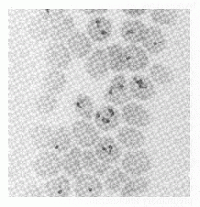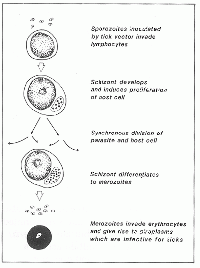Difference between revisions of "East Coast Fever"
| (9 intermediate revisions by 2 users not shown) | |||
| Line 1: | Line 1: | ||
| − | |||
Also Known As: '''''[[Theileriosis - Cattle |Theileriosis]] — Corridor Disease — January Disease — [[Theileria|Theileria parva]] — Exotic Theileriosis — Zimbabwe Theileriosis — Fortuna Disease — Murimu wa ngai''''' (African) — '''''Ol tegana''''' (African) | Also Known As: '''''[[Theileriosis - Cattle |Theileriosis]] — Corridor Disease — January Disease — [[Theileria|Theileria parva]] — Exotic Theileriosis — Zimbabwe Theileriosis — Fortuna Disease — Murimu wa ngai''''' (African) — '''''Ol tegana''''' (African) | ||
| Line 27: | Line 26: | ||
'''Reproductive''' – Abortion, Stillbirths, Agalactia | '''Reproductive''' – Abortion, Stillbirths, Agalactia | ||
| + | |||
| + | '''Urinary''' – Red, brown or pink urine, Haemoglobinuria, Myoglobinuria | ||
| + | |||
| + | '''Dermatological''' – Pruritus, Plaques, Wheals, Papules, Oedema, Subcutaneous masses | ||
'''Other''' – Sudden death, [[Icterus]], Marked Pyrexia, Neurological signs, Emaciation | '''Other''' – Sudden death, [[Icterus]], Marked Pyrexia, Neurological signs, Emaciation | ||
| Line 32: | Line 35: | ||
The clinical phase usually lasts '''2-3 weeks''', but death occasionally occurs within a week. | The clinical phase usually lasts '''2-3 weeks''', but death occasionally occurs within a week. | ||
| − | Sub-lethal acute disease may be followed by complete recovery or | + | Sub-lethal acute disease may be followed by complete recovery or continue as chronic emaciation and decreased productivity and performance. |
===Corridor Disease=== | ===Corridor Disease=== | ||
| − | Acute and usually fatal form of East Coast Fever that occurs when ''T. parva'' is transmitted from '''African buffalo''' to cattle. Buffalo appear to be asymptomatic carriers. | + | Acute and usually fatal form of East Coast Fever that occurs when ''T. parva'' is transmitted from '''African buffalo''' to cattle. Buffalo appear to be asymptomatic carriers and replication of ''T. parva'' is restricted within domestic cattle. |
===January Disease=== | ===January Disease=== | ||
| Line 42: | Line 45: | ||
Also Known As – '''''Zimbabwe theileriosis''''' – '''''Fortuna disease''''' | Also Known As – '''''Zimbabwe theileriosis''''' – '''''Fortuna disease''''' | ||
| − | Acute '''strictly seasonal''' fatal form of ''T. parva'' in Zimbabwe. Occurs only from '''December to May''' | + | Acute '''strictly seasonal''' fatal form of ''T. parva'' in Zimbabwe. Occurs only from '''December to May''' due to the distribution of its vector, ''[[Rhipicephalus spp.|Rhipicephalus]] appendiculatus''. |
Chronic signs such as emaciation and diarrhoea are rarely seen in Corridor disease and January disease due to the short disease course before death. | Chronic signs such as emaciation and diarrhoea are rarely seen in Corridor disease and January disease due to the short disease course before death. | ||
| Line 49: | Line 52: | ||
On post-mortem examination, the lymphoid system is severely damaged and respiratory changes are marked. | On post-mortem examination, the lymphoid system is severely damaged and respiratory changes are marked. | ||
| − | Froth is often present in the trachea, bronchi and bronchioles due to pneumonia and pulmonary oedema. | + | Froth is often present in the trachea, bronchi and bronchioles due to pneumonia and pulmonary oedema. Ulcers may be seen in the peyers patches and necrosis in the lymphoid tissue. |
Lymph nodes and spleen may be hyperplastic. | Lymph nodes and spleen may be hyperplastic. | ||
The heart is commonly petechiated and ecchymotic. | The heart is commonly petechiated and ecchymotic. | ||
| Line 55: | Line 58: | ||
==Treatment== | ==Treatment== | ||
| − | '''Buparvaquone/Parvaquone''' and '''Halofuginone''' chemotherapy drugs | + | '''Buparvaquone/Parvaquone''' and '''Halofuginone''' chemotherapy drugs are effective. |
| − | '''Tetracyclines''' | + | '''Tetracyclines''' are also effective against schizonts. |
'''Immunisation''' with cryopreserved sporozoites is also possible but carries a risk of causing patent disease. | '''Immunisation''' with cryopreserved sporozoites is also possible but carries a risk of causing patent disease. | ||
==Control== | ==Control== | ||
| − | Vaccination with '''cryopreserved sporozoites''' derived from crushed ticks is possible but expensive and not without risks | + | Vaccination with '''cryopreserved sporozoites''' derived from crushed ticks is possible but expensive and not without risks. |
Control of tick vectors and use of tick resistant breeds is also valuable. | Control of tick vectors and use of tick resistant breeds is also valuable. | ||
| Line 80: | Line 83: | ||
| − | {{ | + | {{review}} |
| − | |||
| − | }} | ||
| − | |||
| − | |||
| − | |||
[[Category:Lymphoreticular and Haematopoietic Diseases - Cattle]] | [[Category:Lymphoreticular and Haematopoietic Diseases - Cattle]] | ||
| − | [[Category:CABI Expert Review | + | [[Category:CABI Expert Review]] |
| − | [[Category:Nick | + | [[Category:Nick L]] |
Revision as of 18:36, 25 March 2012
Also Known As: Theileriosis — Corridor Disease — January Disease — Theileria parva — Exotic Theileriosis — Zimbabwe Theileriosis — Fortuna Disease — Murimu wa ngai (African) — Ol tegana (African)
Introduction
East Coast fever is a form of theileriosis caused by Theileria parva.
Signalment
Mainly cattle. Also possibly buffalo.
Distribution
Mainly in tropical regions due to reliance upon tick vectors.
Clinical Signs
Early clinical signs include marked pyrexia, leucopaenia, inappetence, decrease in milk production, lymphadenopathy and palpably hot lymph nodes. As disease progresses, multisystemic signs develop:
Cardiovascular – Tachycardia, Petechiae and Ecchymoses, possibly Anaemia
Respiratory - Nasal discharge, Dyspnoea, Cough
Gastrointestinal – Diarrhoea with mucus and/or blood, Inappetance, Hypomotility, Constipation
Opthalmological – Blindness, Corneal opacity, Discharge, Photophobia, Increased lacrimation
Reproductive – Abortion, Stillbirths, Agalactia
Urinary – Red, brown or pink urine, Haemoglobinuria, Myoglobinuria
Dermatological – Pruritus, Plaques, Wheals, Papules, Oedema, Subcutaneous masses
Other – Sudden death, Icterus, Marked Pyrexia, Neurological signs, Emaciation
The clinical phase usually lasts 2-3 weeks, but death occasionally occurs within a week.
Sub-lethal acute disease may be followed by complete recovery or continue as chronic emaciation and decreased productivity and performance.
Corridor Disease
Acute and usually fatal form of East Coast Fever that occurs when T. parva is transmitted from African buffalo to cattle. Buffalo appear to be asymptomatic carriers and replication of T. parva is restricted within domestic cattle.
January Disease
Also Known As – Zimbabwe theileriosis – Fortuna disease
Acute strictly seasonal fatal form of T. parva in Zimbabwe. Occurs only from December to May due to the distribution of its vector, Rhipicephalus appendiculatus.
Chronic signs such as emaciation and diarrhoea are rarely seen in Corridor disease and January disease due to the short disease course before death.
Diagnosis
On post-mortem examination, the lymphoid system is severely damaged and respiratory changes are marked. Froth is often present in the trachea, bronchi and bronchioles due to pneumonia and pulmonary oedema. Ulcers may be seen in the peyers patches and necrosis in the lymphoid tissue. Lymph nodes and spleen may be hyperplastic. The heart is commonly petechiated and ecchymotic. Petechiae may also be seen throughout the intestines and abomasums in ruminants.
Treatment
Buparvaquone/Parvaquone and Halofuginone chemotherapy drugs are effective.
Tetracyclines are also effective against schizonts.
Immunisation with cryopreserved sporozoites is also possible but carries a risk of causing patent disease.
Control
Vaccination with cryopreserved sporozoites derived from crushed ticks is possible but expensive and not without risks.
Control of tick vectors and use of tick resistant breeds is also valuable.
| East Coast Fever Learning Resources | |
|---|---|
 Test your knowledge using flashcard type questions |
East Coast Fever Flashcards |
References

|
This article was originally sourced from The Animal Health & Production Compendium (AHPC) published online by CABI during the OVAL Project. The datasheet was accessed on 2 June 2011. |
| This article has been peer reviewed but is awaiting expert review. If you would like to help with this, please see more information about expert reviewing. |

